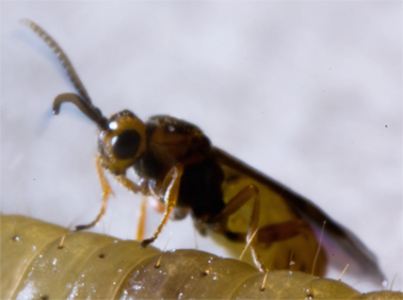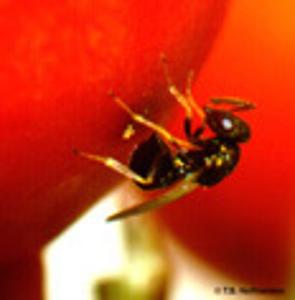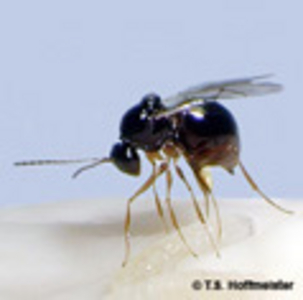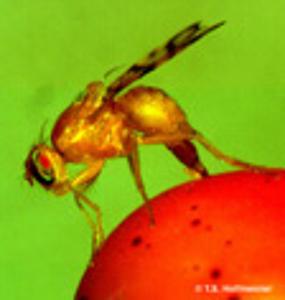Populations- und Evolutionsökologie
Kontakt
AG Populations- und Evolutionsökologie
Institut für Ökologie, FB 2
Universität Bremen
Leobener Str. 5 (NW2)
28359 Bremen, Germany
Prof. Dr. Thomas Hoffmeister
Tel.: +49 (0)421 218-62930
Email: hoffmeister@uni-bremen.de
Administration
Inae Kim-Frommherz,
Tel.: +49 (0)421 218-62945
Email: inaekf@uni-bremen.de
Willkommen bei der AG Populations- und Evolutionsökologie
Die Arbeitsgruppe Populations- und Evolutionsökologie nutzt experimentelle Ansätze, um Schlüsselfaktoren im Wirken natürlicher Selektion auf evolutionäre Veränderungen in Tierpopulationen – vornehmlich Insekten – zu identifizieren. Hierbei kommen Verhaltensbeobachtungen, molekular-genetische, mikrobielle, chemo-ökologische Techniken und statistische Verfahren zum Einsatz. Neben der Grundlagenforschung werden biotechnologische Lösungsansätze in der Kontrolle von Schadorganismen verfolgt. Folgende Forschungsfelder bilden die Hauptschwerpunkte unserer Arbeitsgruppe:
Populationsdynamiken und Ausbreitungsmechanismen invasiver Schadinsekten
Welche Lebenszyklusstrategien und Habitatparameter bestimmen das Invasionspotenzial von Schadinsekten in der Landwirtschaft? Um diese zentrale Frage in der angewandten Entomologie zu beantworten, erforschen wir das Wirtswahl-, Eiablage-, und Verbreitungsverhalten hochinvasiver Fruchtfliegen (Tephritidae) tropischer Regionen und der sich in Europa rasant ausbreitenden Kirschessigfliege (Drosophila suzukii).
Kontakt: Thomas S. Hoffmeister, Marko Rohlfs
Verhalten parasitischer Wespen
Welchen Umweltbedingungen und Erfahrungen ein Insekt in seinem Leben ausgesetzt ist, kann entscheidend sein Verhalten beeinflussen. Wir untersuchen anhand verschiedener Modellsysteme von parasitischen Wespen (u.a. Bracon, Trichogramma oderLeptopilina), welche Faktoren beispielsweise Konkurrenzkraft, Partnerakzeptanz, Eiablagestrategie oder Suchverhalten beeinflussen.
Kontakt: Thomas S. Hoffmeister
Team
Leitung

Prof. Dr. Thomas Hoffmeister
Raum B 4040
+49 (0)421 218-62930
hoffmeister@uni-bremen.de
Administration und Labor
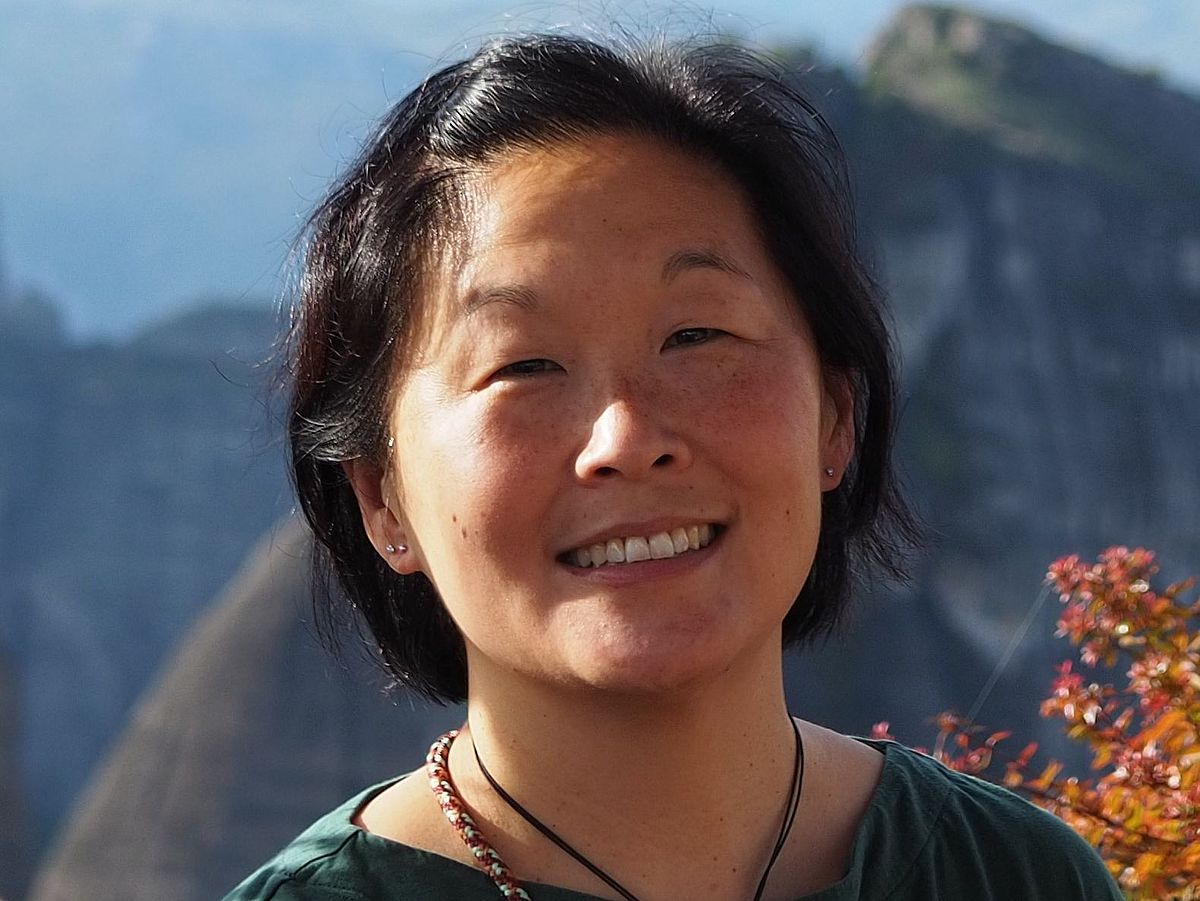
Inae Kim-Frommherz
Administration
Master of Ecology Coordinator
Raum B 4010
+49 (0)421 218-62945
inaekf@uni-bremen.de
Nico Binnemann
Biologielaborant
Room B4010
+49 (0)421 218-62931
Wissenschaftlicher Nachwuchs
Elisabeth Riedel
Doktorandin
Raum B 4080
+49 (0)421 218-62932
eriedel@uni-bremen.de
Hanna Cho
Doktorandin
Raum B 4090
+49 (0)421 218-62944
hannacho85@gmail.com
Studierende
Alexandra Mir Davood Bernal
MSc Biologie
Raum B 4020
alemir@uni-bremen.de
Daniel Kohler
MSc Ecology
Raum B 4020
kohlerda@uni-bremen.de
News
New Special Issue on the Chemical Ecology of Insect-Fungus Interaction, co-edited by Marko Rohlfs, now available at Fungal Ecology
Marko Rohlfs now is Editor-in-Chief of Chemoecology
Publications
Kim B. Ferguson, Bart A. Pannebakker, Alejandra Centurión, Joost van den Heuve, Ronald Nieuwenhuis, Frank F. M. Becker, Elio Schijlen, Andra Thiel, Bas J. Zwaan, Eveline C. Verhulst (2020) Bracon brevicornis Genome Showcases the Potential of Linked-Read Sequencing in Identifying a Putative Complementary Sex Determiner Gene. Genes, 11, 1390; doi:10.3390/genes11121390
Leung, K.; Ras, E.; Ferguson, K.; Ariëns, S.; Babendreier, D.; Bijma, P.; Bourtzis, K.; Brodeur, J.; Bruins, M.; Centurión, A.; Chattington, S.; Chinchilla-Ramírez, M.; Dicke, M.; Fatouros, N.; González Cabrera, J.; Groot, T.; Haye, T.; Knapp, M.; Koskinioti, P.; Le Hesran, S.; Lirakis, M.; Paspati, A.; Pérez-Hedo, M.; Plouvier, W.; Schlötterer, C.; Stahl, J.; Thiel, A.; Urbaneja, A.; van de Zande, L.; Verhulst, E.; Vet, L.; Visser, S.; Werren, J.; Xia, S.; Zwaan, B.; Magalhães, S.; Beukeboom, L.; Pannebakker, B. (2020) Next Generation Biological Control: The Need for Integrating Genetics and Evolution. Biol.Rev., doi: 10.1111/brv.12641 https://onlinelibrary.wiley.com/doi/epdf/10.1111/brv.12641
Rohlfs, M. (2020) Streptomyces’ scent attracts spore dispersers. Nature Microbiology 5, 780–781 https://doi.org/10.1038/s41564-020-0730-0
Contreras-Silva, A.I., Tilstra, A., Migani, V., Thiel, A., Pérez-Cervantes, E., Estrada-Saldívar, N., Elias-Ilosvay, X., Mott, C., Alvarez-Filip, L. & Wild C. (2020) A meta-analysis to assess long-term spatiotemporal changes of benthic coral and macroalgae cover in the Mexican Caribbean. ScientificReports: 10:8897. https://doi.org/10.1038/s41598-020-65801-8
Trienens, M., Rohlfs, M. (2020) A potential collective defence of Drosophila larvae against the invasion of a harmful fungus. Frontiers in Ecology and Evolution. https://doi.org/10.3389/fevo.2020.00079
Kienzle, R., Groß, L., Rohlfs, M. (2020) Resource use by individual Drosophila suzukii reveals a flexible preference for ovipoistion into healthy fruits. Scientific Reports https://doi.org/10.1038/s41598-020-59595-y
Mareike Koppik, Andra Thiel, Thomas S. Hoffmeister (2019) Egg laying rather than host quality or host feeding experience drives habitat estimation in the parasitic wasp Nasonia vitripennis. Ecology and Evolutionhttps://doi.org/10.1002/ece3.5838
Xu, Y., Vinas, M., Alsarrag, A., Su, L., Pfohl, K., Rohlfs, M., Schäfer, W., Chen, W., Karlovsky, P. (2019) Bis-naphthopyrone pigments protect filamentous ascomycetes from a wide range of predators. Nature Communications 10, 3579 https://www.nature.com/articles/s41467-019-11377-5
Biedermann, P.H.W., De Fine Licht, H.H., Rohlfs, M. (2019) Evolutionary chemo-ecology of insect-fungus interactions: Still in its infancy but advancing. Fungal Ecology, 38, 1-6: https://doi.org/10.1016/j.funeco.2018.11.010
Holighaus, G., Rohlfs, M. (2019) Volatile and non-volatile fungal oxylipins in fungus-invertebrate interactions. Fungal Ecology, 38, 28-36: doi.org/10.1016/j.funeco.2018.09.005
Caballero Ortiz, S., Trienens, M., Pfohl, K., Karlovsky, P., Holighaus, G., Rohlfs, M. (2018) Phenotypic responses to microbial volatiles render mold fungi more susceptible to insect damage. Ecology & Evolution, 8: 4328-4339 DOI: doi.org/10.1002/ece3.3978
Biedermann, P., Rohlfs, M. (2017) Evolutionary feedbacks between insect sociality and microbial management
Current Opinion in Insect Science, 22: 92-100 DOI: doi.org/10.1016/j.cois.2017.06.003; recommended in F1000Prime DOI: 10.3410/f.728640243.793541715
Villacañas de Castro, C., Thiel, A.(2017) Clutch size decisions and size-fitness relationships in the gregarious ectoparasitoid Bracon Brevicornis.Journal of Insect behavior 30(4): 454-469
Migani V., Ekesi S., Merkel K., Hoffmeister T. (2017) At Lunch with a Killer: The Effect of Weaver Ants on Host-Parasitoid Interactions on Mango; PLoS ONE 12(2): e0170101. doi.org/10.1371/journal.pone.0170101
Beltran‐Gutierrez, M., Ferse, S.C.A., Kunzmann, A., Stead, S.M., Msuya, F.E., Hoffmeister, T.S., Slater, M.J. (2016) Co-culture of sea cucumber Holothuria scabra and red seaweed Kappaphycus striatum. Aquaculture Research 10/2014; DOI: 10.1111/are.12615
Schuler H., Köppler K., Daxböck‐Horvath S., Rasool B., Krumböck S., Schwarz D., Hoffmeister T.S., Schlick‐Steiner B., Steiner F., Telschow A., Stauffer C., Arthofer W., Riegler M. (2016) The hitchhiker's guide to Europe: the infection dynamics of an ongoing Wolbachia invasion and mitochondrial selective sweep in Rhagoletis cerasi. Molecular Ecology; doi.org/10.1111/mec.13571
Peterson J.H., Hoffmeister T.S., Roitberg B.D. (2016) Variation in maternal solitary bee nest defence related to nest state. Apidologie 47: 90–100
Kruidhof, H.M., Roberts, A.L., Magdaraog, P., Munoz, D., Gols, R., Vet, L.E.M., Hoffmeister, T.S., Harvey, J.A. (2015) Habitat complexity reduces parasitoid foraging efficoency, but does not prevent orientation towards learned host pland odours. Oecologia; DOI 10.1007/s00442-015-3346-y
Ostersehlt, D.,Thiel A. (2015) Die vielen Feinde der Blattlaus. Unterricht Biologie 404, S. 22-27.
Zytynska, S.E., Meyer S.T., Sturm S., Ullmann W., Mehrparver M., Weisser W.W. (2015) Secondary bacterial symbiont community in aphids responds to plant diversity; Oecologia; DOI 10.1007/s00442-015-3488-y
Koppik, M., Hoffmeister, T.S., Brunkhorst, S., Kieß, M., Thiel, A. (2014) Intraspecific variability in associative learning in the parasitic wasp Nasonia vitripennis. Animal Cognition 12/2014; DOI: 10.1007/s10071-014-0828-y
Migani V., Ekesi S., Hoffmeister T.S. (2014) Physiology vs. environment: what drives oviposition decisions in mango fruit flies (Bactrocera invadens and Ceratitis cosyra)? Journal of Applied Entomology; doi.org/10.1111/jen.12038
Thiel, A., Weeda, A.C. (2014) Haploid, diploid, and triploid—discrimination ability against polyploid mating partner in the parasitic wasp, Bracon brevicornis (Hymenoptera: Braconidae). Journal of Insect Science 14(291). DOI: 10.1093/jisesa/ieu153 pdf.
Hoi, A.G., Hoffmeister, T.S., Reid, J., Roitberg, B.D. (2014) Bite or flight: the response of mosquitoes to disturbance while feeding on a defensive host. Entomologia Experimentalis et Applicata 11/2014; DOI: 10.1111/eea.12245
Koppik, M., Thiel, A., Hoffmeister, T.S. (2014) Adaptive decision making or differential mortality: what causes offspring emergence in a gregarious parasitoid? Entomologia Experimentalis et Applicata 03/2014; DOI: 10.1111/eea.12154
Thiel, A., Weeda, A.C., de Boer, J.G., Hoffmeister, T.S. (2013) Genetic incompatibility drives mate choice in a parasitic wasp. Frontiers in Zoology 10:43. pdf.
Wajnberg, E., Hoffmeister, T.S., Coquillard (2013) Optimal within-patch movement strategies for optimising patch residence times: an agent-based modelling approach. Behavioural Ecology and Sociobiology 67 (12): 2053-2063. doi: 10.1007/s00265-013-1615-5.
Migani, V., Ekesi, S., Hoffmeister, T.S. (2013) Physiology vs. environment: what drives oviposition decisions in mango fruit flies (Bactrocera invadens and Ceratitis cosyra)? Journal of Applied Entomology ,doi: 10.1111/jen.12038
Thiel, A., Schlake, S., Kosior, D. (2012) Omnia tempus habent: habitat-specific differences in olfactory learning and decision making in parasitic wasps . Animal Cognition, DOI 10.1007/s10071-012-0567-x
Harvey, J. A., Gols, R., Vet, L.E.M., Kruidhof, H.M. (2012) Development of a hyperparasitoid wasp in different stages of its primary parasitoid and secondary herbivore hosts. Journal of Insect Physiology 58: 1463-1468
Wajnberg, E., Coquillard, P., Vet, L.E.M., Hoffmeister, T.S. (2012) Optimal resource allocation to survival and reproduction in parasitic wasps foraging in fragmented habitats. PLoS ONE 7(6), e38227. doi:10.1371/journal.pone.0038227
Book Chapters (peer reviewed only)
Hoffmeister, T.S., Wajnberg, E. 2008. Finding optimal behaviours with genetic algorithms. In: Behavioural Ecology of Insect Parasitoids - From theoretical approaches to field applications (eds. Bernstein, C., van Alphen, J.J.M., Wajnberg, E.), Blackwell Publishing, 384-401 (pdf)
Hoffmeister, T.S., Babendreier, D. Wajnberg, E. 2006. Statistical tools to improve the quality of experiments for assessing non-target effects. In Biological Control of Arthropods using Invertebrates: Methods for Environmental Risk Assessment (eds. Bigler, F., Babendreier, D., Kuhlmann, U.) CABI Publishing Wallingford, 222-240 (pdf)
Van Lenteren, J.C., Cock, M.J.W., Hoffmeister, T.S., Sands, D.P.A. 2006. Host specificity in arthropod biological control, methods for testing and interpretation of the data. In Biological Control of Arthropods using Invertebrates: Methods for Environmental Risk Assessment (eds. Bigler, F., Babendreier, D., Kuhlmann, U.) CABI Publishing Wallingford, 38-63
Hoffmeister, T.S., Roitberg, B.D. 2002. Evolutionary ecology of oviposition marking pheromons. In: Chemoecology of Insect Eggs and Egg Deposition (eds. Hilker, M.; Meiners, T.) Blackwell Wissenschaftsverlag, Berlin, S. 319-347
Hoffmeister, T.S. 2001. Rhagoletis pomonella (Walsh), Apple Maggot (Diptera: Tephritidae). In: Biological Control Programmes in Canada, 1981-2000 (eds. Mason, P. G.; Huber, J. T.) CABI Publishing, Wallingford, pp 238-241
Hoffmeister, T.S., Vidal, S. 1994. The diversity of fruit fly (Diptera: Tephritidae) parasitoids. In: Parasitoid Community Ecology (eds. B.A. Hawkins, W. Sheehan) Oxford Univ. Press, pp 47-76 (pdf)


